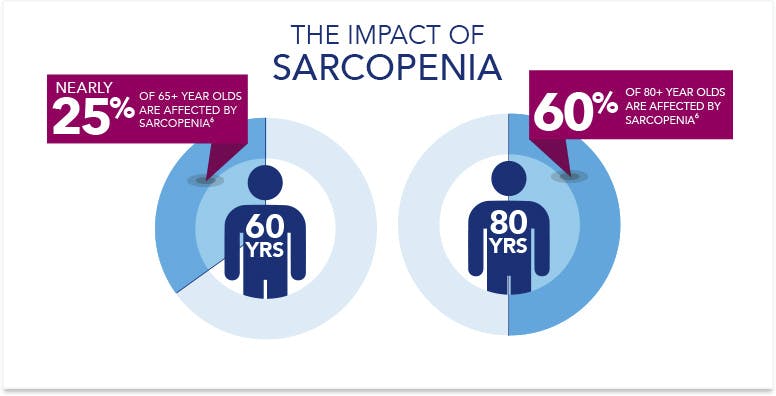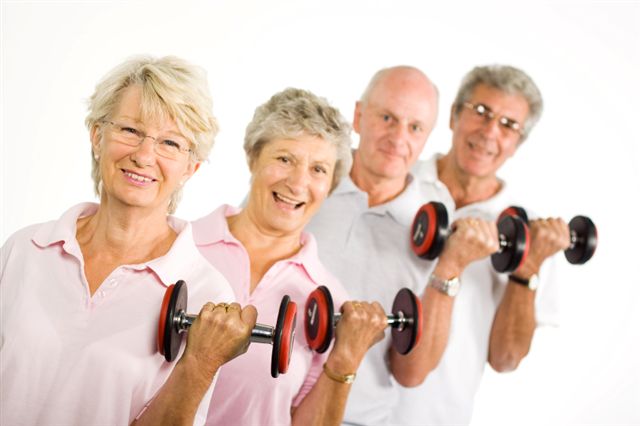Sarcopenia is the term used to describe muscle loss with advancing age. This process begins when you are in your 30s or 40s. It proceeds at a rate of almost 1% each year. Declines in muscle strength usually progress faster than muscle size. Muscle loss with advancing age is associated with many chronic conditions. These include diabetes, cancer, reduced mobility, disability, and mortality. It is estimated that 200 million people worldwide will experience sarcopenia, which could affect their health over the next 4 decades.

Muscle loss is quickly becoming a major public health problem with significant consequences. Exercise and nutritional strategies are considered the primary treatments for age-related muscle loss. The rest of this article summarizes findings from research on muscle loss in older adults and offers some practical solutions related to exercise.
Diet, Supplements, and Muscle Loss
Muscle is made of proteins. Amino acids are the building blocks of proteins. In younger adults (18-30 years old), eating sufficient protein can stimulate some muscle growth by itself. This occurs with or without exercise in younger adults.
However, muscle growth does not come so easily for older adults. Larger amounts of protein in the diet are needed for older adults to preserve or increase muscle. Younger adults show increased muscle protein synthesis with the ingestion of 20 grams of protein during a meal. Older adults require about twice this amount, or 40 grams, to stimulate muscle growth.

Supplementing with protein without exercise does little to preserve muscle mass in older adults. However, increases in muscle size and strength through exercise can be enhanced by certain foods or supplements. Diets rich in dairy and fish containing polyunsaturated fats make your muscles more sensitive to exercise.
There is also evidence showing that protein supplements and creatine monohydrate are beneficial. Most importantly, research shows that a specific type of exercise, resistance exercise, has powerful positive effects on muscles in older adults. Resistance exercise is the key to preserving or increasing your muscle size and strength as you age.
Muscle Loss: The Benefits of Resistance Training

Exercise is a highly effective strategy to offset muscle loss. Exercising with weights has numerous beneficial effects for older adults. These include increases in muscle mass, strength, power, mood, energy levels, walking speed, balance, and functional performance.
Other forms of exercise, such as aerobic exercise, do not confer these same benefits. Aerobic exercise, including regular walking, is not enough to prevent muscle loss in older adults.
Contrary to popular belief, adults older than 75 years old can grow significant muscle through resistance exercise. Heavy weights are not required. Lighter weights with higher repetitions result in significant improvements in muscle size and strength regardless of age.
In all cases, the success of any exercise program depends on adherence and staying committed for the long run. Therefore, it is important to make exercise as enjoyable as possible. Choose resistance exercises you prefer. Exercise with friends. Choose environments (gyms, classes, or in the home) you are most comfortable with. If you are unsure about how to start, work with a personal trainer or your physical therapist.
Developing an Exercise Program to Fight Muscle Loss
Many individuals are unsure about how to structure an exercise program. Those without resistance training experience or those recovering from an injury have questions about what is safe and appropriate. How often? Which exercises? How many sets? How many repetitions? Should you take long or short rests between sets? These are all excellent questions.
Below is a list of recommendations for older adults engaging in resistance exercise. These recommendations are based on research evidence conducted on healthy older adults.
Length of the program |
1 year for the best results, but small improvements are often evident after 6-8 weeks. Ideally, a lifetime commitment is best. |
Frequency per week |
2-3 sessions, preferably with one day of recovery between sessions (i.e., Monday, Wednesday, Friday). |
Duration of each session |
Approximately 1 hour, including rest periods between sets and exercises. |
Exercises per session |
6-8 exercises involving the major muscle groups of the upper and lower body. |
Sets per exercise |
2-3 sets result in greater improvements than single-set routines. |
Intensity
|
50-80% of a one-repetition maximum, which is the maximum amount of weight you can perform properly for one repetition. An easier guide is to use the recommendations for repetitions per set below. |
Repetitions per set |
7-9 repetitions per set are optimal for strength and muscle development. This means you should only be able to perform 1-3 more repetitions beyond this range before fatigue stops you. If you can perform more than this amount without requiring a rest break, increase the weight. |
Duration of each repetition |
6 seconds of slow, controlled movements are recommended. Muscle power development requires faster tempos of movement. |
Rest between sets |
1-2 minutes is optimal. If this seems like a long time, perform some aerobic activity, such as brisk walking, between sets. |
Choosing Which Resistance Exercises to Perform
Contrary to the opinions of some, there are no good or bad exercises. The selection of exercises should be based on several considerations. This is where a personal trainer or your physical therapist can help. As mentioned, the most important consideration is to choose exercises you enjoy performing. Beyond this idea, below are some general recommendations and a few examples.
- Incorporate exercises done in standing positions as opposed to seated or lying down. For example, choose the bodyweight squat over the seated leg press.
- Choose free weights over machines whenever possible. Not all machines are bad, but using free weights requires greater muscle activation, control, and coordination.
- Exercises using multiple joints are preferred over single-joint movements. For example, choose the cable row over the biceps curl.
- Incorporate at least one exercise for the fundamental movement patterns, such as the squat, hip hinge, upper body push (presses), and upper body pull (row).
What Are You Waiting For?
Aging is accompanied by a decline in physical activity and function. Loss of muscle contributes to these changes and is also a consequence of them. This creates a vicious cycle characterized by muscle loss, weakness, declining function, and the development of chronic conditions. Other negative consequences ensue, such as osteoporosis and increased body fat.
Exercise can slow down these processes and even reverse them. Resistance exercise is one of the most effective means to combat the effects of aging and many chronic diseases. Some have referred to resistance exercise as the “Fountain of Youth.”
Dietary strategies and supplements can enhance the effects of exercise. However, there is no magic pill. Success requires goals, a plan, positive habits, and commitment. Call your physical therapist if you need help getting started. With every passing day, you are losing muscle and becoming weaker.

